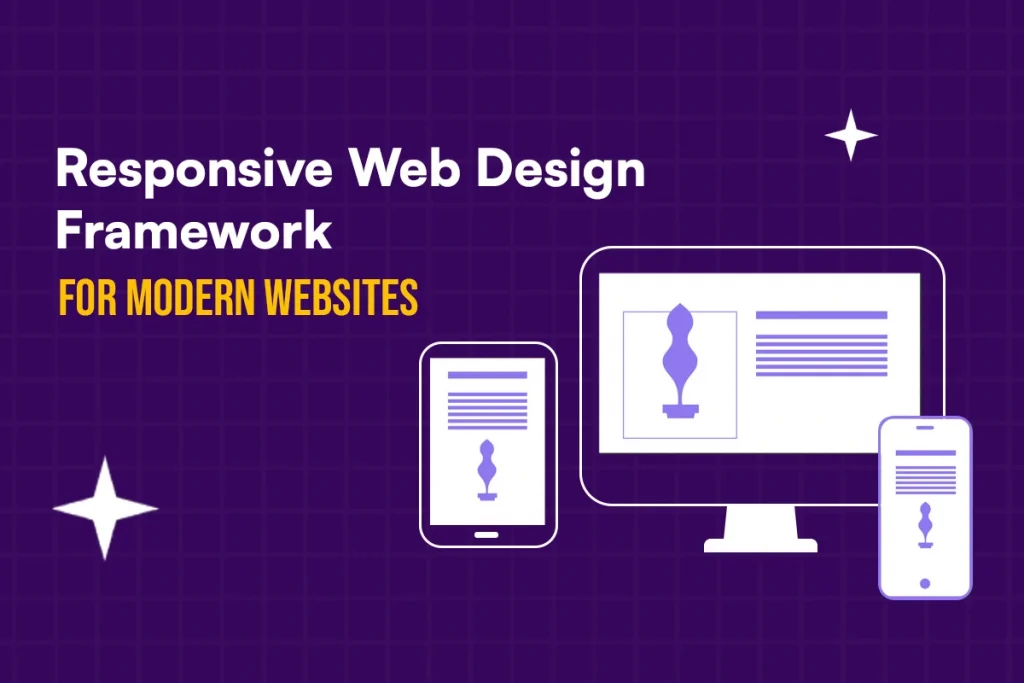Creating websites that adjust easily to different devices or screen sizes has become a necessity in today’s digital environment. Moving into 2024, it is vital to note that responsive web design frameworks have grown increasingly important as new technologies arise and user demands change. Hence, this blog post looks at current trends, technologies, and best practices in relation to responsive web design, specifically how they connect with custom software development, the future of React Native, and other advancements in this area.
What’s the Need?
Taking care of a website seems to be the most important thing, even more so than picking the right front-end platform. This is because so many people use cell phones, and if your website isn’t mobile-friendly, it might not look perfect on those devices.
In the beginning, some companies realized this need and began to develop flexible online design systems that could significantly facilitate product creation without compromising quality.
Most service providers opt for using responsive web design tools since they are less complex and more effective. They are generally sold as a full set that includes all the off-canvas designs needed for any web development process.
You should also remember that adaptable web design platforms are basically software that has enough HTML, CSS, and JavaScript codes to make adaptive web design easy. However, there are different systems out there.
So, have you ever had a moment when you thought about what software development system seemed most suitable for front-end development? Or maybe you’ve pondered which UI design is better? It’s high time we considered some of the best dynamic web design tools capable of creating responsive websites that can last and thrive over the years.
The Evolution of Responsive Web Design
Responsive web design has come a long way since Ethan Marcotte first coined the term in 2010. Responsive design came into being as a new way of dealing with different sizes of screens, but now it’s a core tenet of web development. When we talk about responsive design today, we do not mean just adjusting layouts; rather, it refers to the ability to deliver smooth and seamless interactions across an infinite number of devices that are available on the market.
Key Components of Modern Responsive Frameworks:
- Fluid Grids: Advanced grid systems that automatically adjust based on screen size and orientation.
- Flexible Images: Techniques for ensuring images scale appropriately without losing quality or impacting performance.
- Media Queries: More sophisticated queries that go beyond screen size to consider device capabilities and user preferences.
- Performance Optimization: Built-in tools for minimizing load times and ensuring smooth experiences on all devices.
- Accessibility Features: Integrated support for creating inclusive designs that work for all users.
The Rise of Mobile-First Web Design

Mobile-first web design has become much more important as the number of mobile devices has grown. During the design and development process, this method works on making the mobile experience better. This makes sure that websites are not only responsive, but also perfectly sized for smaller screens.
Benefits of Mobile First Design:
- Improved User Experience: By focusing on core content and functionality for mobile users first, designers create more streamlined and efficient interfaces.
- Better Performance: Mobile-first designs tend to be lighter and faster-loading, benefiting users across all devices.
- Future-Proofing: As new devices with varying screen sizes emerge, mobile-first designs are better positioned to adapt.
Custom Software Development in Responsive Design
The intersection of custom software development and responsive web design is where true innovation happens. Since companies are looking for ways to make themselves different from others as well as establish themselves in terms of their unique user experiences, more and more customized solutions based on responsive frameworks seem to appear every day.
Trends in Custom Responsive Development:
- Micro-Interactions: These are short, engaging animations that give feedback and make the user experience better.
- Progressive Web Apps (PWAs): These are web apps that offer a user-friendly experience like native apps, including offline functionality and push notifications.
- Voice user interfaces (VUIs): Let you use voice commands and responses in responsive web designs.
- Augmented Reality (AR) Elements: Incorporating AR features that adapt to different devices and screen sizes.
Responsive frameworks that extend beyond traditional grid systems and media queries are required for these bespoke elements. Greater flexibility and personalization are now possible among programmers due to the development of modular, component-modelled architectures.
Most Popular Web Development Frameworks for Responsive Design
While custom solutions are on the rise, many developers still rely on established frameworks to streamline their workflow. Here’s a look at some of the most popular web development frameworks for creating responsive websites in 2024:
- Bootstrap 5: Still a favourite for its comprehensive component library and robust grid system.
- Tailwind CSS: Gaining popularity for its utility-first approach and highly customizable nature.
- Foundation: Known for its enterprise-level features and accessibility support.
- Bulma: A modern CSS framework based on Flexbox, praised for its simplicity and clean design.
- Material-UI: A popular choice for React developers, offering a wide range of pre-built components following Material Design principles.
Each of these frameworks has its strengths, and the choice often depends on project requirements, team expertise, and specific design goals.
The Future of React Native and Responsive Web Design
React Native has mainly been developed for mobile applications, but it is increasingly being used for web projects. The prospects for React Native’s future in responsive web design seem bright, with several significant advancements to pay attention to:
- React Native for Web: This project allows developers to use React Native components and APIs for web development, potentially streamlining the process of creating truly cross-platform, responsive applications.
- Enhanced Performance: Ongoing improvements to React Native’s architecture is resulting in better performance for web applications, rivalling traditional responsive websites.
- Component-Based Design: React Native’s component-based approach aligns well with modern responsive design principles, allowing for highly modular and adaptable interfaces.
- Integration with Progressive Web Apps: As Progressive Web Applications (PWAs) continue to gain traction, React Native’s capacity to produce app-like experiences on the internet is becoming more important.
Challenges and Considerations:
- Learning Curve: Developers accustomed to traditional web development may need time to adapt to React Native’s paradigms.
- Browser Support: While improving, React Native for Web may not offer the same level of browser compatibility as more established web frameworks.
- Performance Overhead: For simpler websites, the additional complexity of React Native might not be justified.
How AI and Machine Learning is taking its place in Responsive Web Design
The integration of AI & Machine Learning into responsive web design is one of the most exciting developments in recent years. These technologies are enabling more intelligent, adaptive, and personalized web experiences.
Applications of AI in Responsive Design:
- Automated Layout Generation: AI algorithms can analyse content and user behaviour to suggest optimal layouts for different devices and contexts.
- Personalized User Experiences: Machine learning models can adapt content, navigation, and design elements based on individual user preferences and behaviours.
- Predictive Loading: AI can anticipate user actions and preload content, improving perceived performance across devices.
- Intelligent Image Optimization: Machine learning algorithms can automatically crop, resize, and compress images for optimal display on different devices.
- Accessibility Enhancements: AI-powered tools can analyse websites for accessibility issues and suggest improvements, ensuring better experiences for all users.
- Chatbots and Virtual Assistants: These AI-driven interfaces can adapt their behaviour and appearance based on the device and context.
Challenges in Implementing AI-Driven Responsive Design:
- Data Privacy Concerns: The use of AI often requires collecting and analysing user data, raising privacy issues that need to be carefully addressed.
- Complexity: Integrating AI and ML into responsive design can add significant complexity to projects, potentially increasing development time and costs.
- Maintaining Human Touch: While AI can offer powerful optimizations, it’s crucial to maintain the human element in design to ensure emotional connections with users.
Best Practices for Modern Responsive Web Design
As we look to the future of responsive web design, several best practices emerge:
- Performance First: With Google’s Core Web Vitals now a ranking factor, ensuring fast load times and smooth interactions across all devices is crucial.
- Accessibility by Design: Building accessibility into the core of responsive frameworks, rather than treating it as an afterthought.
- Content-driven Breakpoints: Moving beyond standard device sizes to create breakpoints based on content needs.
- Fluid Typography: Implementing responsive type that scales smoothly across different screen sizes.
- Device-agnostic Design: Creating flexible layouts that work well on current devices and are prepared for future form factors.
- Testing Across Devices: Utilizing real device testing and emulators to ensure consistent experiences across a wide range of devices and browsers.
- Progressive Enhancement: Building a solid base experience that works for all users, then layering on enhancements for more capable devices and browsers.
The Overview
In the responsive web design world, rapid evolution is occasioned by technologies, user behaviours, and an ever-expanding range of devices. As one looks to the future, the difference between web applications and native applications continues to blur using such technologies as React Native that challenge the possibilities in cross-platform development. Despite this fact, the principles of mobile-first web design remain relevant, ensuring the optimization of websites for the devices that most users rely on. Success in such a dynamic landscape requires knowledge of trends and technologies while being informed by basic aspects of good design and user experience. By balancing innovation with established practices, developers can create responsive sites that not only satisfy contemporary customers but also stand ready for future challenges and opportunities.




